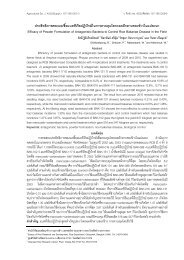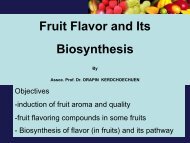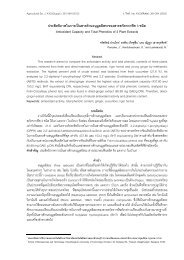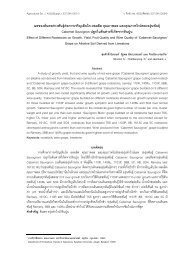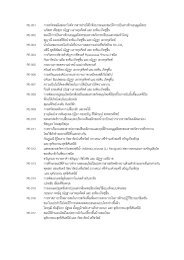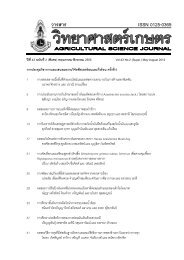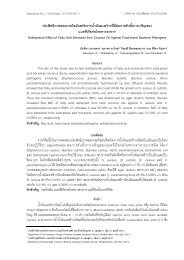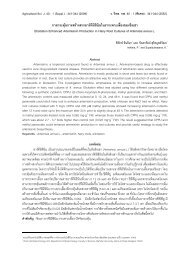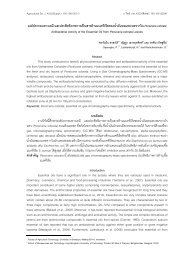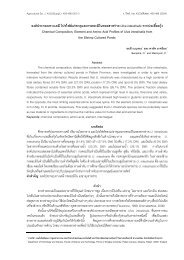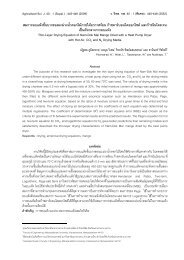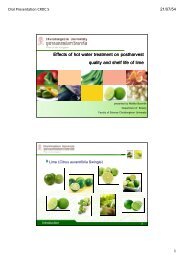part.6 - CRDC
part.6 - CRDC
part.6 - CRDC
Create successful ePaper yourself
Turn your PDF publications into a flip-book with our unique Google optimized e-Paper software.
ว. วิทยาศาสตรเกษตร ปที่ 40 ฉบับที่ 1 (พิเศษ) มกราคม-เมษายน 2552 ประสิทธิภาพของสารสกัดจากมะนาว 93<br />
สรุป<br />
สารสกัดจากมะกรูดดวยวิธีการตมกลั่นและสกัดดวยตัวทําละลายทั้ง 2 ชนิดคือแอลกอฮอลและปโตรเลียมอีเทอรมี<br />
%yield มากที่สุดคือ เทากับ 2.188 2.563 และ 2.429 w/w ตามลําดับ สวนการศึกษาประสิทธิภาพในการยับยั้งเชื้อจุลินทรีย<br />
ทั้ง 7 ชนิดพบวาสารสกัดจากเปลือกสมโอดวยวิธีตมกลั่นสามารถยับยั้งการเจริญของเชื้อไดดีทั้งหมดโดยเชื้อ S. cerevisiae,<br />
Penicillium sp. และ B.cereus ถูกยับยั้งไดมากที่สุดคือมี clear zone เทากับ 20 mm E. coli S. cereus และ L.<br />
mesenteroides มี clear zone เทากับ 18 15 และ 13 mm ตามลําดับ<br />
คําขอบคุณ<br />
ขอบคุณสํานักงานสนับสนุนกองทุนวิจัยที่ไดใหทุนสนับสนุนงานวิจัยในครั้งนี้<br />
เอกสารอางอิง<br />
Alzoreky, N.S. and K. Nakahara. 2002. Antimicrobial activity of extracts from some edible plants commonly<br />
consumed in Asia. International Journal of Food Microbiology. 80: 223-230.<br />
Basilico, M.Z. and J.C. basilica. 1999. inhibitory effects of some spice essential oils on Aspergillus ochraceus<br />
NRRL 3174 growth and ochratoxin A production. Letters in Applied Microbiology. 29: 238-241.<br />
Ben-Yehosha, S., V. Rodov and J. Perez. 1998. Constitutive and induced resistance of citrus fruits against<br />
pathogens. In G.I. Johnson, E. Highly, and D.C. Joyce (Eds.), Disease resistance in fruits. ACIAR<br />
proceeding. vol.80 (pp. 78-89). Canberra, Australia: Australian Center for International Agricultural<br />
Research.<br />
Bowles, B.L., S.K. Sackitey and A.C. William. 1995. Inhibitory effect of flavor compound on Staphylococcus aureus<br />
WRRC B124. Journal of Food Safety. 15: 337-347.<br />
Caccioni, D.R.L., M. Guizzardi, D.M. Biondi, A. renda, and G. Ruberto. 1998. Relationships between volatile<br />
components of citrus fruit essential oils and antimicrobial action on Penicillium digitatum and Penicillium<br />
italicum. International Journal of Food Microbiology. 43: 73-79.<br />
Delaquis, P.J., K. Stanich, B. Girard and G. Mazza. 2002. Antimicrobial activity of individual and mixed fractionsof<br />
dill, citantro, coriander and eucalyptus essential oils. International Journal of Food Microbiology. 74: 101-<br />
109.<br />
Dorman, H.J.D. and S.G. Deans. 2000. Antimicrobial against from plants; antimicrobial activity of plant volatile oils.<br />
Journal of Applied Microbiology. 88: 308-316.<br />
Kim, J., M.R. Marshall, J.A. Cornell, L.F. Preston and C. Wei. 1995. Antibacterial activity of carevacrol, citral and<br />
geraniol against Salmonella typhimurium in culture medium and on fish cubes. Journal Food Science.<br />
60: 1364-1368.<br />
Güllüce, M., H. KaramanI, M. Sengül and A. Adıgüzel. 2003. Antimicrobial activity of aqueous and methanol<br />
extracts of Juniperus oxycedrus L. Journal of Ethnopharmacology. 85: 231–235.<br />
.<br />
Table 1 Properties of plant extracts from Lime, Kaffir Lime, and Pummelo<br />
plant Lime (leaves) kaffir lime (leaves) Pummelo (rind)<br />
Physical –<br />
chemical Hydro EtOH PE Hydro EtOH PE Hydro EtOH PE<br />
properties distillation<br />
distillation<br />
distillation<br />
%yield(w/w) 0.452 1.328 0.577 2.188 2.563 2.429 0.520 1.247 0.968<br />
RI 1.242 Nd Nd 1.725 Nd Nd 1.133 Nd Nd<br />
Phenolic<br />
compound 0.081 0.011 0.012 0.040 0.022 0.013 0.057 0.011 0.004<br />
Pesticide<br />
residue none none none none none none none none none



